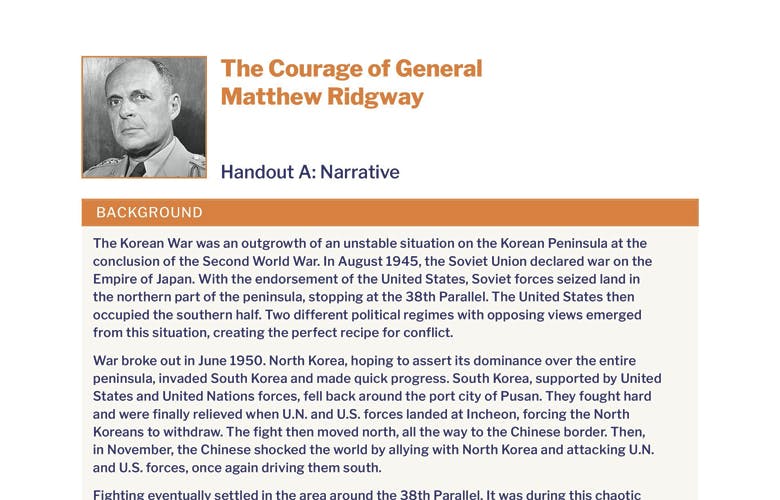The Courage of General Matthew Ridgway – Handout A: Narrative
BACKGROUND
The Korean War was an outgrowth of an unstable situation on the Korean Peninsula at the conclusion of the Second World War. In August 1945, the Soviet Union declared war on the Empire of Japan. With the endorsement of the United States, Soviet forces seized land in the northern part of the peninsula, stopping at the 38th Parallel. The United States then occupied the southern half. Two different political regimes with opposing views emerged from this situation, creating the perfect recipe for conflict.
War broke out in June 1950. North Korea, hoping to assert its dominance over the entire peninsula, invaded South Korea and made quick progress. South Korea, supported by United States and United Nations forces, fell back around the port city of Pusan. They fought hard and were finally relieved when U.N. and U.S. forces landed at Incheon, forcing the North Koreans to withdraw. The fight then moved north, all the way to the Chinese border. Then, in November, the Chinese shocked the world by allying with North Korea and attacking U.N. and U.S. forces, once again driving them south.
Fighting eventually settled in the area around the 38th Parallel. It was during this chaotic situation that General Matthew Ridgway arrived on the Korean Peninsula.
NARRATIVE
Matthew Ridgway was born into a military family in March 1895. His father, Colonel Thomas Ridgway, was an artillery officer. Upon graduating high school, Ridgway applied for the United States Military Academy, West Point. However, he failed the entrance exam. Not to be easily dissuaded, Ridgway applied again, this time successfully. He graduated and was commissioned in 1917, just as America was entering the First World War.
Much to Ridgeway’s disappointment, however, he was not assigned to a combat role. Instead, he became a Spanish instructor and was assigned to his alma mater, West Point. After the war concluded, Ridgway remained in the Army, serving in various posts around the world. During this interwar period, Ridgway proved himself as an able officer with excellent organizational and logistical skills.
Despite his success, Ridgway was eager to prove himself in a combat command. When the United States became embroiled in the Second World War in December of 1941, Ridgway was assigned to the War Plans Division. In August 1942, he was promoted to Major General and assigned to command the 82nd Airborne Division. At the time, however, it was just another infantry division. General Ridgway was tasked with transitioning it to an airborne unit.
Ridgway made the transition successful and had his men ready in time to make their first combat jump into Sicily in July 1943. After fighting in Italy, the division was transferred to England to be a part of the allied invasions in Normandy in June of 1944. Ridgway jumped into combat with his men in the early morning hours of June 6, taking command of his scattered elements in the field. Ridgway then went on to command the XVIII Airborne Corps in Holland during Operation Market Garden. While in this command, he also assisted in pushing back the desperate German offense in the Ardennes, known as the Battle of the Bulge. Finally, he led is men into Germany during Operation Varsity, suffering a grenade wound in the process.
Throughout the Second World War, Ridgway proved himself as an able combat commander. He was cool under fire and gained the respect of the men he commanded. Never afraid to expose himself to the danger of combat, he did all that he could to prevent the death of his men in vain or misguided operations.
This experience would serve him well when he was asked to take command of a beleaguered and exhausted 8th Army on the Korean Peninsula in 1950. The army he took charge of was tired, demoralized, and disillusioned with the mission at hand. Men shivered in foxholes due to a lack of proper equipment and hot meals. They pined for home because of poor organization in the mail services. Defeatism infected the army and its officers. Ridgway knew the task ahead of him would be difficult.
In addition to the difficult situation on the ground, Ridgway’s had health concerns. At the age of 55, he was no longer the younger man he had been during the Second World War. He had recently suffered a heart attack and was nearing the age when most military men retired from active duty. However, General Ridgway knew the gravity of the situation at hand, and his purpose was clear.
After meeting with Douglas McArthur, the overall commander of forces in Korea, Ridgway set to work. He relieved many of his subordinate and exhausted commanders, replacing them with fresh and energetic men. He fixed the mail problem, got hot food to the front, and moved up fresh supplies. After sitting through a long briefing where his officers explained to him defensive plan after defensive plan, Ridgway asked them what their plan was for an offensive. When they told him they had no such plans, Ridgway set them to design one.
By spring of 1951, the army was reorganized and on the offensive. Utilizing airpower and artillery, Ridgway’s forces wreaked havoc on the Chinese, pushing them north of the 38th Parallel. In April of 1952, when President Truman removed Douglas McArthur from command, Ridgway was placed in charge of all U.N. forces in Korea.
Ridgway’s brave and bold actions during that miserable winter on the Korean Peninsula salvaged the conflict from an almost eminent defeat. Though the war would drag on, it is in no small part thanks to General Matthew Ridgway that the South Korean nation is free and prosperous. By combating defeatism and promoting concerted action under his command, he demonstrated courage while working to achieve his mission.
